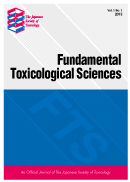
- |<
- <
- 1
- >
- >|
-
Masayuki Sato, Jin-Yong Lee, Min-Seok Kim, Tsutomu Takahashi, Akira Na ...2018 年 5 巻 2 号 p. 71-73
発行日: 2018/04/18
公開日: 2018/04/18
ジャーナル フリーWe previously reported fluctuating levels of many metabolites in the brain of mice administered methylmercury. In this study, addition of putrescine, a polyamine, to the medium was found to confer methylmercury resistance to C17.2 mouse neural stem cells with regard to metabolites increased by methylmercury in the mouse brain. However, putrescine had little effect on the cytotoxicity of heavy metals such as cadmium and inorganic mercury. These results suggest that putrescine may selectively alleviate methylmercury toxicity.
抄録全体を表示PDF形式でダウンロード (929K)
-
Takashi Yamada, Yushiro Tanaka, Ryuichi Hasegawa, Toshime Igarashi, Ak ...2018 年 5 巻 2 号 p. 75-82
発行日: 2018/04/18
公開日: 2018/04/18
ジャーナル フリーProlongation of prothrombin time (PT) induced by industrial chemicals was characterized using a database of repeated dose toxicity studies, HESS DB. Of the 685 chemicals in the DB, 20 chemicals markedly prolonged the PT by more than 150% of that of vehicle control. Prolonged PTs were detected in males for 20 chemicals but no significant prolongation of PT was observed in females for 19/20 chemicals, indicating that males are apparently more susceptible to PT prolongation than females. The effective dose of the chemicals for males were relatively high, in the range of 100 to 1,000 mg·kg-1·day-1, compared to the dose range of 60 to 100 μg·kg-1·day-1 for warfarin, a typical anticoagulant. Since not all chemicals had severe hepatotoxic effects at these doses, the low protein synthesis capacity of the liver may not contribute to prolonged PT. The mechanism of PT prolongation by the chemicals was considered different from that of warfarin, which is a specific inhibitor of vitamin K epoxide reductase, because of large differences in their effective dose and lack of structural similarity between them. Herein, the possible mechanisms of PT prolongation by industrial chemicals in males are explored, with a focus on the action of estradiol and vitamin K.
抄録全体を表示PDF形式でダウンロード (1461K)
-
Masaaki Kurata, Gakushi Kito, Kazuyo Sadamoto, Shingo Nemoto2018 年 5 巻 2 号 p. 83-85
発行日: 2018/04/23
公開日: 2018/04/25
ジャーナル フリーThe systemic dose levels of eye-drop drugs are relatively low in comparison with that of systemic routes such as oral administration. We undertook overall risk assessment of eye-drop drugs for developmental and reproductive toxicity (DART) by comparing the estimated systemic dose level of eyedrop drugs with the known threshold of toxicological concern (TTC) for DART. The systemic dose level of eye-drop drugs in human were estimated to be 0.0005 to 0.05 mg/kg/day on the assumption of 0.01% to 1% of eye drop formulation, 0.04 mL/eye/time of instillation volume, and 60 kg body weight. The TTCs for DART ranged from 0.003 mg/day (0.00005 mg/kg/day; for anticacer drugs) to 7.860 mg/day (0.131 mg/kg/day). Therefore, the range of estimated systemic dose level of eye-drop drugs was almost overlapped with known TTC values for DART, excepting for that applied to the anticacer drugs. These knowledge simply indicates the safety of eye-drop drugs for DART from a view pont of absolute dosage levels, implying allowance of case by case basis planning non-clinical DART study.
抄録全体を表示PDF形式でダウンロード (467K)
-
Moussa Ndong, Nathan Mise, Masaki Okunaga, Fujio Kayama2018 年 5 巻 2 号 p. 87-91
発行日: 2018/05/22
公開日: 2018/05/22
ジャーナル フリーExposure to Cadmium (Cd), Arsenic (As), and Lead (Pb) in short or long term can cause health problems in humans. Rice is particularly susceptible to heavy metals contamination. Rice is the major staple food of different developing countries like Senegal leading to high exposure of the population to heavy metals if the rice is contaminated. In Senegal, two types of rice are consumed: local rice mainly produced in the Senegal river valley and imported rice from Asian countries. Thus, the objective of this study was to determine heavy metals accumulation in rice grains produced in Senegal or imported. Samples of five rice varieties produced in three different areas of the Senegal river valley and samples of imported rice from Japan, Thailand and Pakistan were analyzed for As, Cd and Pb contamination. The results showed that all samples were conform in term of contamination by As, Cd and Pb. Changes in heavy metals contamination were noticed between some rice varieties and according to localities. They were not a significant difference in the risk of exposure to heavy metals between the consumption of local produced rice and imported rice. However, the high rice intake of Senegalese could affect the safety of dietary intake of these metals by rice.
抄録全体を表示PDF形式でダウンロード (212K)
- |<
- <
- 1
- >
- >|